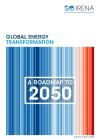
-
-
IRENA (2019), Global energy transformation: A roadmap to 2050 (2019 edition), International Renewable Energy Agency, Abu Dhabi.
Copied
/-/media/Files/IRENA/Agency/Publication/2019/Apr/IRENA_Global_Energy_Transformation_2019.pdf
Copied
Global energy transformation: A roadmap to 2050 (2019 edition)
Newsletter
Increased use of renewable energy, combined with intensified electrification, could prove decisive for the world to meet key climate goals by 2050. This study from the International Renewable Energy Agency (IRENA) highlights immediately deployable, cost-effective options for countries to fulfil climate commitments and limit the rise of global temperatures. The envisaged energy transformation would also reduce net costs and bring significant socio-economic benefits, such as increased economic growth, job creation and overall welfare gains.
The report – the second under the Global Energy Transformation banner – expands IRENA’s comprehensive roadmap, which examines technology pathways and policy implications to ensure a sustainable energy future. Ramping up electricity to over half of the global energy mix (up from one-fifth currently) in combination with renewables would reduce the use of fossil fuels, responsible for most greenhouse-gas emissions.
See the digital story based on this report: How to Transform Energy System And Reduce Carbon Emissions

Global energy transformation: The REmap transition pathway
A comprehensive background report presents technical findings on the status of the shift to renewable energy and the REmap transition pathway.
Renewables already make up more than half of newly installed power-generation capacity. Yet their overall share in the energy mix (including power, heat and transport) needs to grow six times faster, IRENA’s analysis shows.
National climate commitments under the Paris Agreement largely hinge on energy decarbonisation. The historic 2015 climate deal, endorsed nearly worldwide, calls for keeping the rise in average global temperatures “well below” two degrees Celsius (2oC) during the present century, compared to pre-industrial levels.
Achieving a climate-safe future, however, depends on swift global action. Current plans and policies, including Nationally Determined Contributions (NDCs), fall far short. Energy-related emissions have risen around 1% yearly since 2015, while the world’s “carbon budget” looks set to run out within a decade.
Among other findings:
- Based on IRENA’s analysis, energy-related carbon-dioxide (CO2) emission reductions would have to decline 70% by 2050, compared to current levels, to meet climate goals. A large-scale shift to electricity from renewables could deliver 60% of those reductions; 75% if renewables for heating and transport are factored in; and 90% with ramped-up energy efficiency.
- With electricity becoming the dominant energy carrier, global power supply could more than double, the report finds. Renewable sources, including solar and wind, could meet 86% of power demand.
- The energy transformation would boost gross domestic product (GDP) by 2.5% and total employment by 0.2% globally in 2050. It would also bring broader social and environmental benefits. Health, subsidy and climate-related savings would be worth as much as USD 160 trillion cumulatively over a 30-year period, the report finds. Thus, every dollar spent in transforming the global energy system provides a payoff of at least USD 3 and potentially more than USD 7, depending on how externalities are valued.
- Renewables, meanwhile, would create more new jobs than those lost in fossil-fuel industries. Policy inputs can further improve the socio-economic footprint of the transformation.





